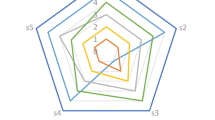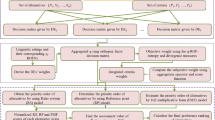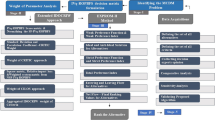Abstract
Evaluation and prioritization are indispensable for selecting the appropriate FWTT (food waste treatment technique). Previous research shows that the decision methods are suitable for selecting FWTTs. Nevertheless, current literature on choosing FWTTs seldom considers the impact of experts’ bounded rational behavior and interactive criteria, especially with uncertain information. This article proposes a q-ROFS (q-rung orthopair fuzzy set)-generalized TODIM (an acronym in Portuguese for interactive and multi-criteria decision-making method)-based hybrid framework for coping with the selection problem of FWTTs. In the information fusion process, the fuzziness and ambiguity of information are expressed by the q-ROFS. Then, the q-ROFS-CRITIC (criteria importance through inter-criteria correlation) method is introduced to calculate the criteria weights considering the interactive criteria. Next, the q-ROFS-generalized TODIM framework is presented to rank the alternative techniques considering the experts’ bounded rational behavior. Finally, a real case of selecting FWTTs with q-ROFSs is performed to examine the applicability and feasibility of this framework. The result shows that the alternative \(f_{2}\) (anaerobic digestion) has the highest priority for food waste treatment with the largest overall dominance degree value. After that, a sensitivity study of different parameters and comparative analysis with similar selection methods are organized to elaborate on the reasonability of the provided framework.






Similar content being viewed by others
Explore related subjects
Discover the latest articles, news and stories from top researchers in related subjects.Abbreviations
- AD:
-
Anaerobic digestion
- CP:
-
Composting
- CRITIC:
-
Criteria importance through inter-criteria correlation
- EDAS:
-
Distance from average solution
- FAO:
-
Food and agriculture organization
- FFS:
-
Fermatean fuzzy set
- FW:
-
Food waste
- FWTT:
-
Food waste treatment technique
- HD:
-
Degree of hesitancy
- IFS:
-
Intuitionistic fuzzy set
- IN:
-
Incineration
- LF:
-
Landfill
- MCDM:
-
Multi-criteria decision-making
- MULTIMOORA:
-
Multi-attribute multi-objective optimization with the ratio analysis
- PFS:
-
Pythagorean fuzzy set
- q-ROFS:
-
Q-rung orthopair fuzzy set
- TODIM:
-
Acronym in Portuguese for interactive and multi-criteria decision-making
- WA:
-
Weighted averaging
- \(\tilde{P}\) :
-
A q-ROFS
- \(\gamma_{{\tilde{P}}} \left( x \right)\) :
-
Degree of membership
- \(\delta_{{\widetilde{P}}} \left( x \right)\) :
-
Degree of non-membership
- \(\mu_{{\widetilde{P}}} \left( x \right)\) :
-
Degree of hesitancy
- \(S\left( {\tilde{g}} \right)\) :
-
Score function
- \(H\left( {\tilde{g}} \right)\) :
-
Accuracy function
- \(\widehat{d}\left( {g_{1} ,g_{2} } \right)\) :
-
Distance between two fuzzy numbers
- \(v^{t}\) :
-
A group of experts
- \(f_{i}\) :
-
Each alternative
- \(f_{1}\) :
-
CP
- \(f_{2}\) :
-
AD
- \(f_{3}\) :
-
IN
- \(f_{4}\) :
-
LF
- \(z_{j}\) :
-
Each criterion
- \(\widetilde{{A^{t} }}\) :
-
Q-ROFS evaluation matrix
- \(\overline{{\widetilde{{a_{{_{ij} }}^{t} }}}}\) :
-
Mean values of the individual matrix
- \(B\) :
-
Similarity measure
- \(w_{t}\) :
-
Weights of experts
- \(\overset{\lower0.5em\hbox{$\smash{\scriptscriptstyle\frown}$}}{A}\) :
-
Group decision matrix
- \(a^{\prime}_{ij}\) :
-
Score matrix
- \(\sigma_{j}\) :
-
Standard deviation value
- \(r_{{jj^{\prime}}}\) :
-
Correlation coefficient
- \(w_{j}\) :
-
Criteria weights
- \(l_{j}\) :
-
Quantity of information on criteria
- \(\Phi_{j} \left( {f_{i} ,f_{{i^{\prime}}} } \right)\) :
-
Dominance grade
- \(\Phi \left( {f_{i} } \right)\) :
-
Overall dominance degree
References
Wang W., Cao, Y., Deveci, M., Wu, Q.: An extensible complex spherical fuzzy decision making model based selection framework for the food waste treatment method. Appl. Soft Comput. 150 111068 (2024)
Xue, L., Liu, X., Lu, S., Cheng, G., Hu, Y., Liu, J., Dou, Z., Cheng, S., Liu, G.: China’s food loss and waste embodies increasing environmental impacts. Nat. Food. 2(7), 519–528 (2021)
Minnuse, T.J., Fangninou, F.F., Bowen, A.M., Cao, J., Wu, B., Moleli, I.A.: Food waste: waste or resource? Current practices and status. Int. J. Sci. Res. Publ. 10(1), 735–739 (2020)
Bernstad Saraiva Schott, A., Wenzel, H., la Cour-Jansen, J.: Identification of decisive factors for greenhouse gas emissions in comparative life cycle assessments of food waste management: an analytical review. J. Clean. Prod. 119, 13–24 (2016)
Rani, P., Mishra, A.R., Krishankumar, R., Ravichandran, K.S., Kar, S.: Multi-criteria food waste treatment method selection using single-valued neutrosophic-CRITIC-MULTIMOORA framework. Appl. Soft Comput. 111, 107657–107670 (2021)
Wang, W., Chen, Y., Wang, Y., Deveci, M., Moslem S., Coffman, D.M.: Unveiling the implementation barriers to the digital transformation in the energy sector using the Fermatean cubic fuzzy method. Appl. Energy. 360 122756 (2024)
Wang, W., Han, X., Ding, W., Wu, Q., Chen, X., Deveci, M.: A Fermatean fuzzy Fine–Kinney for occupational risk evaluation using extensible MARCOS with prospect theory. Eng. Appl. Artif. Intell. 117, 105518–105530 (2023)
Tripathi, D., Nigam, S.K., Mishra, A.R., Shah, A.R.: A novel intuitionistic fuzzy distance measure-SWARA-COPRAS method for multi-criteria food waste treatment technology selection. Oper. Res. Eng. Sci. Theory Appl. (2022). https://doi.org/10.31181/oresta111022106t
Fetanat, A., Tayebi, M., Mofid, H.: Water-energy-food security nexus based selection of energy recovery from wastewater treatment technologies: an extended decision making framework under intuitionistic fuzzy environment. Sustain. Energy Technol. Assess. 43, 100937–100955 (2021)
Chaurasiya, R., Jain, D.: Pythagorean fuzzy entropy measure-based complex proportional assessment technique for solving multi-criteria healthcare waste treatment problem. Granul. Comput. 7(4), 917–930 (2022)
Ramya, L., Narayanamoorthy, S., Manirathinam, T., Kalaiselvan, S., Kang, D.: An extension of the hesitant Pythagorean fuzzy ELECTRE III: techniques for disposing of e-waste without any harm. Appl. Nanosci. 13, 1939–1957 (2022)
Rani, P., Mishra, A.R., Saha, A., Hezam, I.M., Pamucar, D.: Fermatean fuzzy Heronian mean operators and MEREC-based additive ratio assessment method: an application to food waste treatment technology selection. Int. J. Intell. Syst. 37(3), 2612–2647 (2021)
Yager, R.R.: Generalized orthopair fuzzy sets. IEEE Trans. Fuzzy Syst. 25(5), 1222–1230 (2017)
Deveci, M., Pamucar, D., Gokasar, I., Koppen, M., Gupta, B.B.: Personal mobility in metaverse with autonomous vehicles using q-rung orthopair fuzzy sets based OPA-RAFSI model. IEEE Trans. Intell. Transp. Syst. (2022). https://doi.org/10.1109/TITS.2022.3186294
Xiao, L., Huang, G., Pedrycz, W., Pamucar, D., Martínez, L., Zhang, G.: A q-rung orthopair fuzzy decision-making model with new score function and best-worst method for manufacturer selection. Inf. Sci. 608, 153–177 (2022)
Kumar, K., Chen, S.-M.: Group decision making based on q-rung orthopair fuzzy weighted averaging aggregation operator of q-rung orthopair fuzzy numbers. Inf. Sci. 598, 598–616 (2022)
Deveci, M., Gokasar, I., Pamucar, D., Coffman, D.M., Papadonikolaki, E.: Safe E-scooter operation alternative prioritization using a q-rung orthopair Fuzzy Einstein based WASPAS approach. J. Clean. Prod. 347, 131239–131257 (2022)
Saha, A., Mishra, A.R., Rani, P., Hezam, I.M., Cavallaro, F.: A q-rung orthopair fuzzy FUCOM double normalization-based multi-aggregation method for healthcare waste treatment method selection. Sustainability 14(7), 4171–4199 (2022)
Mishra, A.R., Rani, P., Pamucar, D., Hezam, I.M., Saha, A.: Entropy and discrimination measures based q-rung orthopair fuzzy MULTIMOORA framework for selecting solid waste disposal method. Environ. Sci. Pollut. Res. 30, 12988–13011 (2023)
Soni, A., Das, P.K., Kumar, S.: Application of q-rung orthopair fuzzy based SWARA-COPRAS model for municipal waste treatment technology selection. Environ. Sci. Pollut. Res. 30(37), 88111–88131 (2023)
Narayanamoorthy, S., Anuja, A., Pragathi, S., Sandra, M., Ferrara, M., Ahmadian, A., Kang, D.: Assessment of inorganic solid waste management techniques using full consistency and extended MABAC method. Environ. Sci. Pollut. Res. (2023). https://doi.org/10.1007/s11356-11023-29195-11350
Naz, S., Akram, M., Naseer, I., Saeid, A.B., Fatima, A.: 2-Tuple linguistic q-rung orthopair fuzzy power MSM approach for choosing sustainable waste disposal technology. Sci. Iran. (2023). https://doi.org/10.24200/SCI.22023.60804.27006
Khan, A., Rehman, N., Al-Duais, F.S., Al-Bossly, A., Al-Essa, L.A., Tag-eldin, E.M.: A novel decision model with Einstein aggregation approach for garbage disposal plant site selection under q-rung orthopair hesitant fuzzy rough information. AIMS Math. 8(10), 22830–22874 (2023)
Kang, D., Anuja, A., Ahmadian, A., Manirathinam, T., Shanmugam, P., Narayanamoorthy, S.: Sustainable assessment of plastic and mixed waste disposal problem during COVID-19 pandemic: an integrated multi-criteria decision-making approach. Environ. Dev. Sustain. (2023). https://doi.org/10.1007/s10668-10023-03175-10663
Narayanamoorthy, S., Anuja, A., Brainy, J.V., Manirathinam, T., Pragathi, S., Nallasivan Parthasarathy, T., Kang, D.: Assessment of the solid waste disposal method during COVID-19 period using the ELECTRE III method in an interval-valued q-rung orthopair fuzzy approach. Comput. Model. Eng. Sci. 131(3), 1229–1261 (2022)
Seker, S.: IoT based sustainable smart waste management system evaluation using MCDM model under interval-valued q-rung orthopair fuzzy environment. Technol. Soc. 71, 102100–102113 (2022)
Ali, J.: A q-rung orthopair fuzzy MARCOS method using novel score function and its application to solid waste management. Appl. Intell. 52(8), 8770–8792 (2021)
Ling, J., Li, X., Lin, M.: Medical waste treatment station selection based on linguistic q-rung orthopair fuzzy numbers. Comput. Model. Eng. Sci. 129(1), 117–148 (2021)
Buyuk, A.M., Temur, G.T.: Food waste treatment option selection through spherical fuzzy AHP. J. Intell. Fuzzy Syst. 42(1), 97–107 (2022)
Abu, R., Aziz, M.A.A., Sapuan, N., Abdullah, T.A.T., Hassan, C.H.C., Noor, Z.Z.: Multi-criteria decision approach with stakeholders for food waste management. IOP Conf. Ser. Earth Environ. Sci. 756(1), 012005–012014 (2021)
Wang, W., Liu, X., Chen, X., Qin, Y.: Risk assessment based on hybrid FMEA framework by considering decision maker’s psychological behavior character. Comput. Ind. Eng. 136, 516–527 (2019)
Llamazares, B.: An analysis of the generalized TODIM method. Eur. J. Oper. Res. 269, 1041–1049 (2018)
Wu, Q., Liu, X., Qin, J., Wang, W., Zhou, L.: A linguistic distribution behavioral multi-criteria group decision making model integrating extended generalized TODIM and quantum decision theory. Appl. Soft Comput. 98, 106757–106777 (2021)
Tang, J., Liu, X., Wang, W.: Consensus-based generalized TODIM approach for occupational health and safety risk analysis with opinion interactions. Appl. Soft Comput. 150, 111093–111122 (2023)
Huang, G., Xiao, L., Zhang, G.: An integrated design concept evaluation method based on best–worst entropy and generalized TODIM considering multiple factors of uncertainty. Appl. Soft Comput. 140, 110165–110203 (2023)
Wen, H., Chen, Y., Wang, W., Ding, L.: A q-rung orthopair fuzzy generalized TODIM method for prioritizing barriers to sustainable food consumption and production. J. Intell. Fuzzy Syst. 45(3), 5063–5074 (2023)
Wu, X., Zhu, Z., Chen, G., Pedrycz, W., Liu, L., Aggarwal, M.: Generalized TODIM method based on symmetric intuitionistic fuzzy Jensen–Shannon divergence. Expert Syst. Appl. 237, 121554–121572 (2024)
Garg, A., Das, S., Maiti, J., Pal, S.K.: Granulized Z-VIKOR model for failure mode and effect analysis. IEEE Trans. Fuzzy Syst. 30(2), 297–309 (2022)
Wang, W., Liu, X., Qin, J., Shuli, L.: An extended generalized TODIM for risk evaluation and prioritization of failure modes considering risk indicators interaction. IISE Trans. 11, 1236–1250 (2019)
Zhang, H., Wang, H., Wei, G.: Spherical fuzzy TODIM method for MAGDM integrating cumulative prospect theory and CRITIC method and its application to commercial insurance selection. Artif. Intell. Rev. 56(9), 10275–10296 (2023)
Aytekin, A., Okoth, B.O., Korucuk, S., Mishra, A.R., Memiş, S., Karamaşa, Ç., Tirkolaee, E.B.: Critical success factors of lean six sigma to select the most ideal critical business process using q-ROF CRITIC-ARAS technique: case study of food business. Expert Syst. Appl. 224, 120057–120073 (2023)
Mishra, A.R., Chen, S.-M., Rani, P.: Multicriteria decision making based on novel score function of Fermatean fuzzy numbers, the CRITIC method, and the GLDS method. Inf. Sci. 623, 915–931 (2023)
Haktanır, E., Kahraman, C.: A novel picture fuzzy CRITIC & REGIME methodology: wearable health technology application. Eng. Appl. Artif. Intell. 113, 104942–104956 (2022)
Peng, X., Garg, H.: Intuitionistic fuzzy soft decision making method based on CoCoSo and CRITIC for CCN cache placement strategy selection. Artif. Intell. Rev. 55(2), 1567–1604 (2021)
Garg, H., Chen, S.-M.: Multiattribute group decision making based on neutrality aggregation operators of q-rung orthopair fuzzy sets. Inf. Sci. 517, 427–447 (2020)
Liu, P., Wang, P.: Some q-rung orthopair fuzzy aggregation operators and their applications to multiple-attribute decision making. Int. J. Intell. Syst. 33(2), 259–280 (2018)
Peng, X., Liu, L.: Information measures for q-rung orthopair fuzzy sets. Int. J. Intell. Syst. 34(8), 1795–1834 (2019)
Verma, R., Álvarez-Miranda, E.: Group decision-making method based on advanced aggregation operators with entropy and divergence measures under 2-tuple linguistic Pythagorean fuzzy environment. Expert Syst. Appl. 231, 120584–120616 (2023)
Liu, P., Rani, P., Mishra, A.R.: A novel Pythagorean fuzzy combined compromise solution framework for the assessment of medical waste treatment technology. J. Clean. Prod. 292, 126047–126424 (2021)
Komal: Archimedean t-norm and t-conorm based intuitionistic fuzzy WASPAS method to evaluate health-care waste disposal alternatives with unknown weight information. Appl. Soft Comput. 146, 110751–110774 (2023)
Alkan, N., Kahraman, C.: An intuitionistic fuzzy multi-distance based evaluation for aggregated dynamic decision analysis (IF-DEVADA): its application to waste disposal location selection. Eng. Appl. Artif. Intell. 111, 104809–104834 (2022)
Chakraborty, S., Saha, A.K.: Novel Fermatean Fuzzy Bonferroni Mean aggregation operators for selecting optimal health care waste treatment technology. Eng. Appl. Artif. Intell. 119, 105752–105768 (2023)
Patel, A., Jana, S., Mahanta, J.: Intuitionistic fuzzy EM-SWARA-TOPSIS approach based on new distance measure to assess the medical waste treatment techniques. Appl. Soft Comput. 144, 110521–110543 (2023)
Alkan, N., Kahraman, C.: Evaluation of government strategies against COVID-19 pandemic using q-rung orthopair fuzzy TOPSIS method. Appl. Soft Comput. 110, 107653 (2021)
Du, W.S.: Concise representations and limiting cases of q-rung orthopair fuzzy Hamacher-Bonferroni mean aggregations. Comput. Appl. Math. 42(8), 357–390 (2023)
Ashraf, A., Ullah, K., Hussain, A., Bari, M.: Interval-valued picture fuzzy maclaurin symmetric mean operator with application in multiple attribute decision-making. Rep. Mech. Eng. 3(1), 301–317 (2022)
Wang, W., Cao, Y., Deveci, M., Wu, Q.: An extensible complex spherical fuzzy decision making model based selection framework for the food waste treatment method. Appl. Soft Comput. 150, 111068–111114 (2024)
Peng, X., Krishankumar, R., Ravichandran, K.S.: A novel interval-valued fuzzy soft decision-making method based on CoCoSo and CRITIC for intelligent healthcare management evaluation. Soft. Comput. 25(6), 4213–4241 (2021)
Torkayesh, A.E., Malmir, B., Rajabi Asadabadi, M.: Sustainable waste disposal technology selection: the stratified best-worst multi-criteria decision-making method. Waste Manag. 122, 100–112 (2021)
Palaniveloo, K., Amran, M.A., Norhashim, N.A., Mohamad-Fauzi, N., Peng-Hui, F., Hui-Wen, L., Kai-Lin, Y., Jiale, L., Chian-Yee, M.G., Jing-Yi, L., Gunasekaran, B., Razak, S.A.: Food waste composting and microbial community structure profiling. Processes 8(6), 723–753 (2020)
Meng, Q., Liu, H., Zhang, H., Xu, S., Lichtfouse, E., Yun, Y.: Anaerobic digestion and recycling of kitchen waste: a review. Environ. Chem. Lett. 20(3), 1745–1762 (2022)
Llamazares, B.: An analysis of the generalized TODIM method. Eur. J. Oper. Res. 269(3), 1041–1049 (2018)
Wang, W., Liu, X., Qin, Y., Fu, Y.: A risk evaluation and prioritization method for FMEA with prospect theory and Choquet integral. Saf. Sci. 110, 152–163 (2018)
Alattas, K., Wu, Q.: A framework to evaluate the barriers for adopting the internet of medical things using the extended generalized TODIM method under the hesitant fuzzy environment. Appl. Intell. 52(12), 13345–13363 (2022)
Acknowledgements
This work was supported by the Social Science Planning Project of Anhui province (AHSKQ2021D56).
Author information
Authors and Affiliations
Corresponding author
Appendix
Appendix
See Tables 17, 18, 19, 20, 21, 22, 23, 24, 25, 26, 27, and 28.
Rights and permissions
Springer Nature or its licensor (e.g. a society or other partner) holds exclusive rights to this article under a publishing agreement with the author(s) or other rightsholder(s); author self-archiving of the accepted manuscript version of this article is solely governed by the terms of such publishing agreement and applicable law.
About this article
Cite this article
Cao, Y., Wu, X., Ding, L. et al. A Hybrid Framework for Selecting Food Waste Treatment Techniques Using q-Rung Orthopair Fuzzy CRITIC-Generalized TODIM Method. Int. J. Fuzzy Syst. 26, 1916–1935 (2024). https://doi.org/10.1007/s40815-024-01714-2
Received:
Revised:
Accepted:
Published:
Issue Date:
DOI: https://doi.org/10.1007/s40815-024-01714-2




